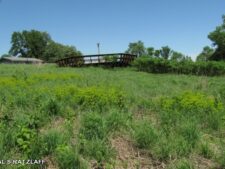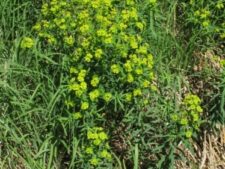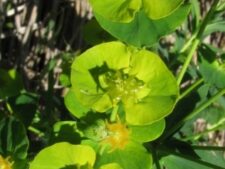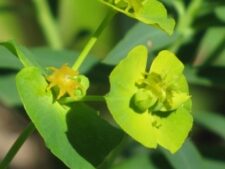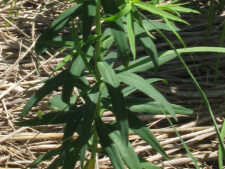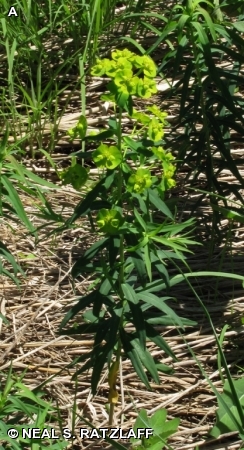
This aggressive, introduced Eurasian plant spreads from seeds and shoots arising from its deep horizontal roots. Erect, hairless stems usually are from 1 to 2 feet tall. Leaves are mostly alternate, although they may be opposite or whorled near the top. They are hairless with smooth margins, lance-shaped and up to 4 inches long by 1/2 inch wide. Both the stem and leaves contain a milky white latex-like juice. Flowers are borne on long stems arising from the leaf axils and in an umbrella-like cluster at the tip. The unique and very inconspicuous flowers are known as cyathia. They consist of up to 25 stamens surrounding a single female flower, several yellowish glands with curved, pointed tips (E) and the most visible portion made up ot 2 heart-shaped yellowish bracts up to 1/2 inch in diameter which lie directly beneath. (D,E)
This unwelcome addition to our flora was first identified in Knull Prairie in the spring of 2009 just to the right and beyond the Astronomy deck. To date, this is the only known occurrence of this dreaded plant at either NW or FF.
At the time these photos were taken in 2010 there were well over 100 plants. They are being aggressively managed with herbicides with some success, it would appear. Leafy spurge has become well established in the northern U.S. and has become especially troublesome in grasslands of Nebraska and prairie states and provinces to the north. It is very difficult to eradicate requiring multiple applications, making chemical control with herbicides difficult and expensive. More recently European beetles and midges known to feed on leafy spurge have been introduced and have shown promise in controlling this scourge of our grasslands.
The content of NatureSearch is provided by dedicated volunteer Naturalists of Fontenelle Forest who strive to provide the most accurate information available. Contributors of the images retain their copyrights. The point of contact for this page is: Roland Barth.

